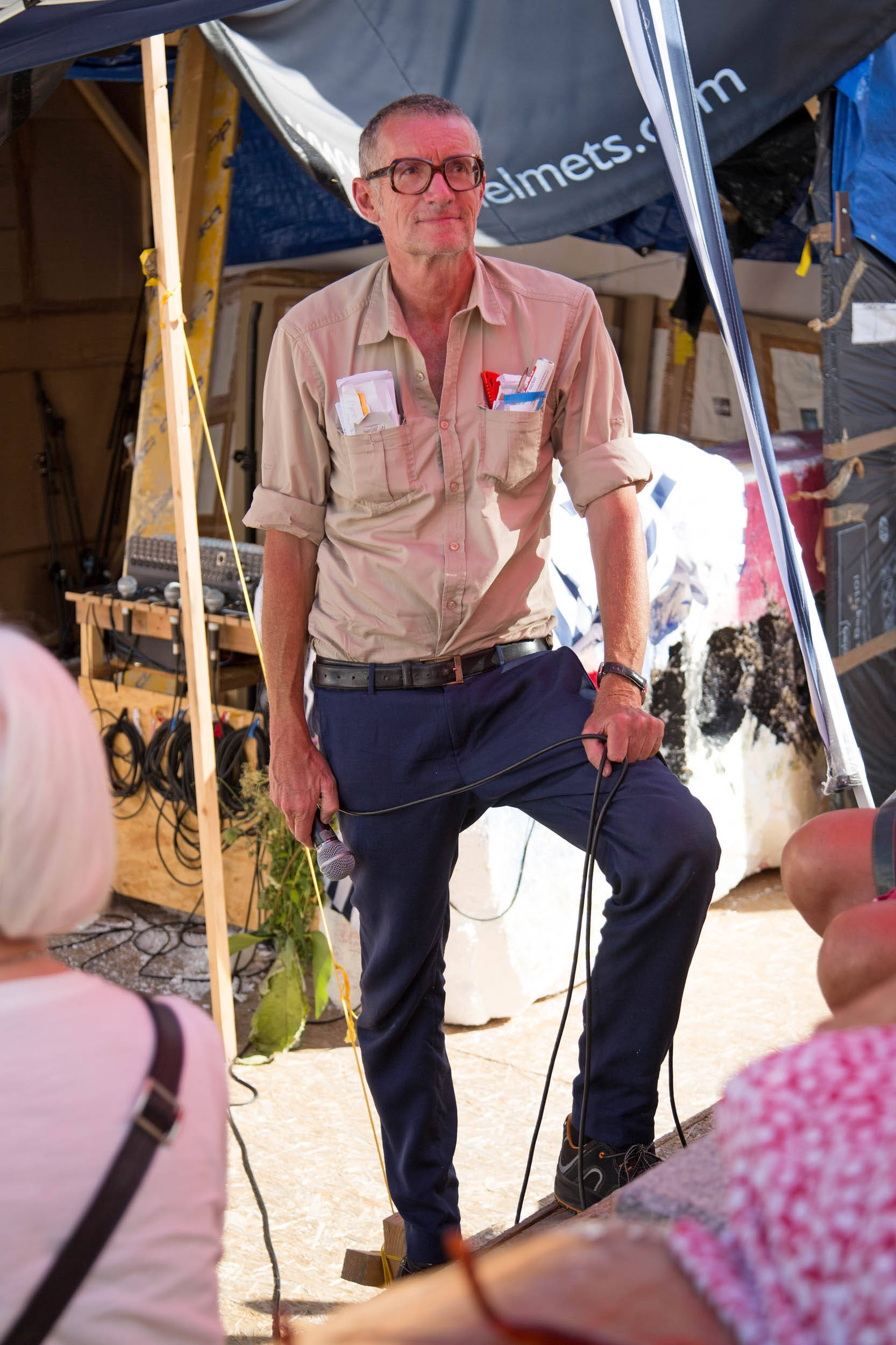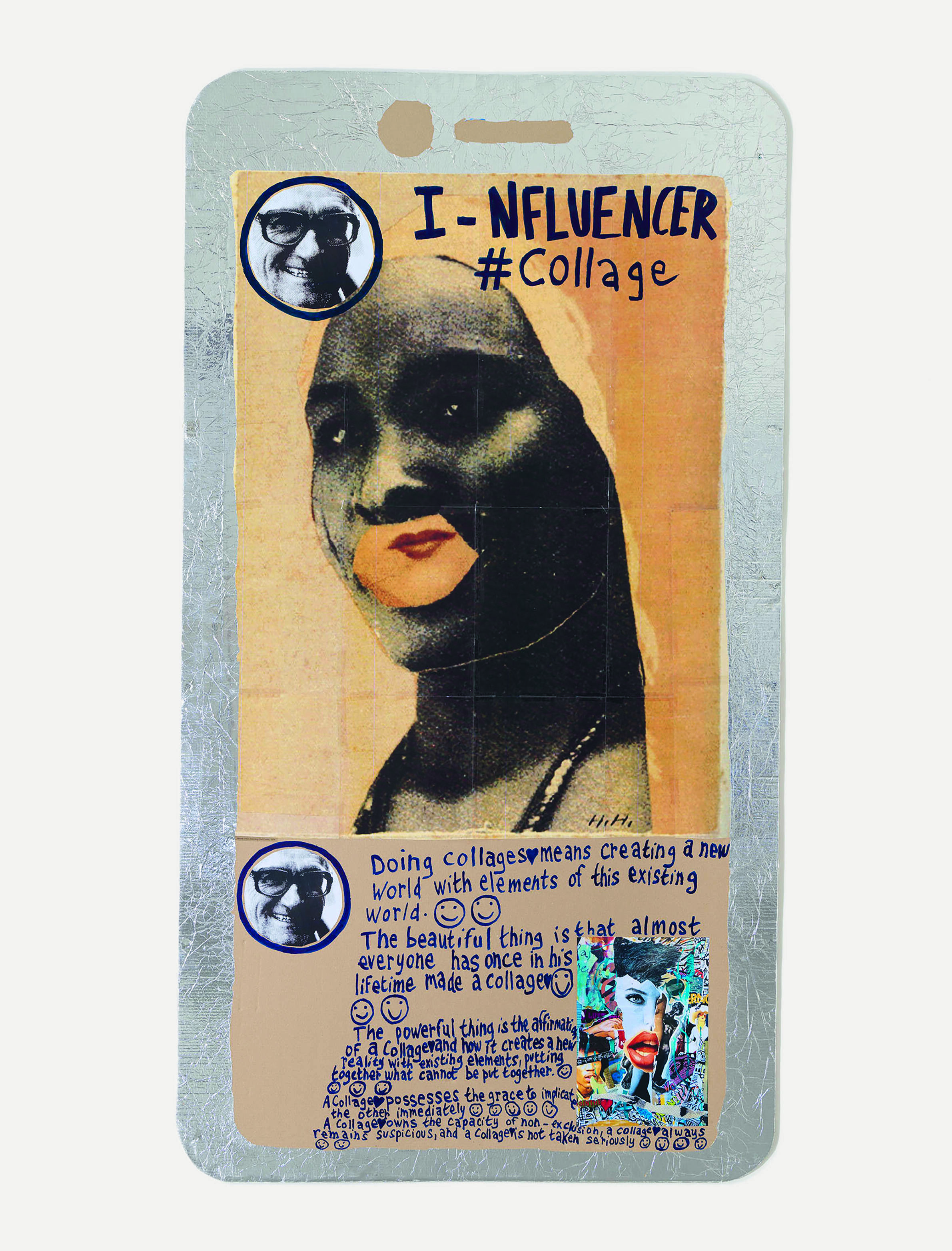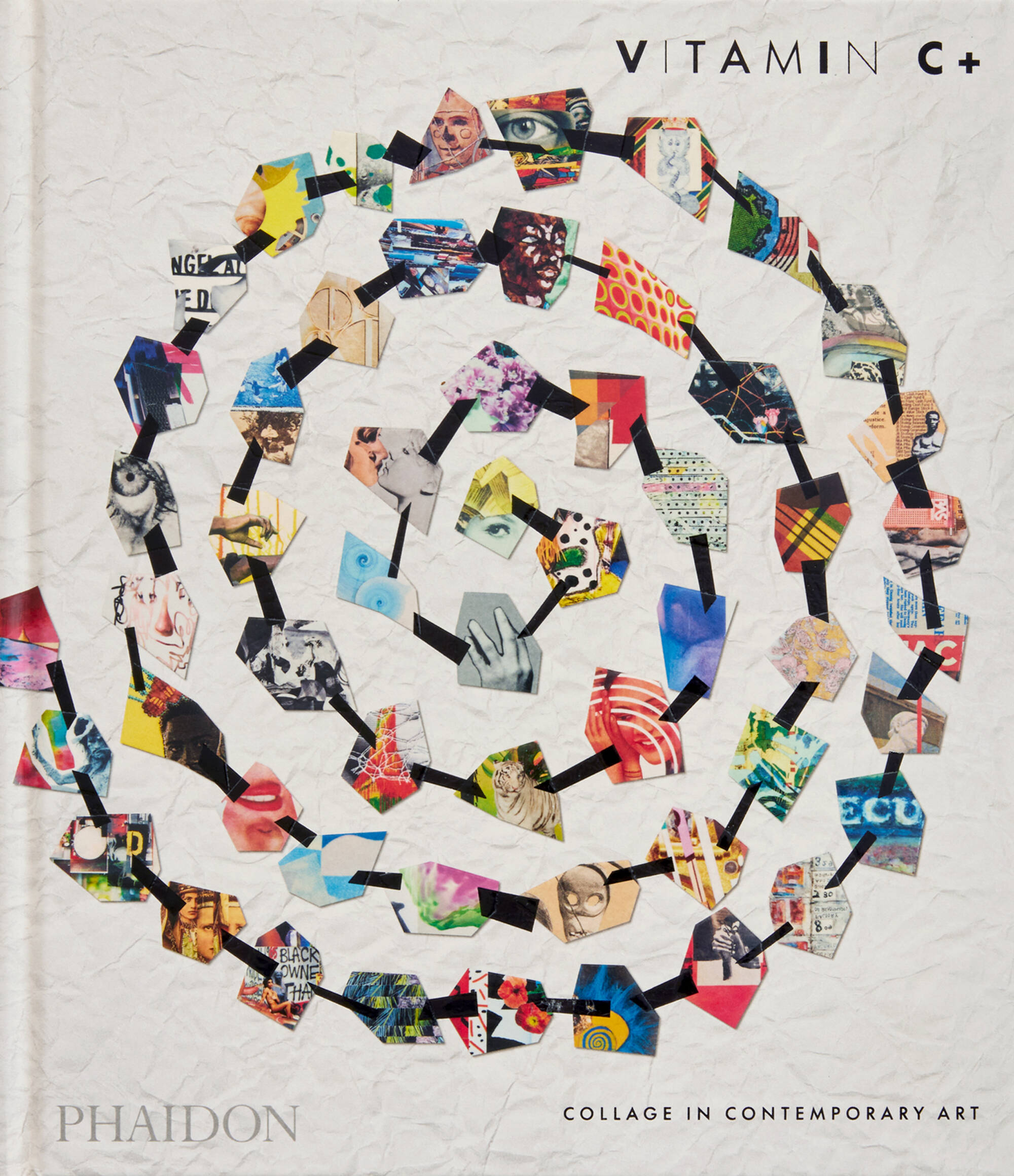
Thomas Hirschhorn - Why I Make Collage
The Vitamin C+ featured artist explains how he wants to create a new world within our existing one
The most difficult thing in doing a collage, is to know when to stop working on it, when the edge of affirmation is reached, and exactly the point of 'no-return' is touched," the Swiss artist Thomas Hirschhorn tells Phaidon.com.
Hirschorn's approach, as he describes it ot us, is "to create a new world in the existing world, to glue together what does not stick together. In order to do a collage, I need to act without my head, with courage, in pure affirmation, and with the instinct to make a break-through."
Hirschhorn is one of 108 artists featured in Vitamin C+ Collage in Contemporary Art which showcases living artists who employ collage as a central part of their visual-art practice. The artists have been chosen by 69 experts in the field, including museum directors, curators, critics, and collectors. Yuval Etgar, an internationally renowned expert in the area provides the introduction and writes many of the excellent texts. Phaidon.com is talking to a select group of artists featured in the book.
We caught up with Thomas Hirschhorn to find out who turned him on to collage, how, in his words a good collage has "artistic grace, political strength and poetic dimension," and why his collages are "for eternity, despite the precarity of life."
 Thomas Hirschhorn, De-Pixelation, 2017 Exhibition view: Gladstone Gallery, New York, 2017 Photo: David Regen Courtesy of the artist and Gladstone Gallery, New York
Thomas Hirschhorn, De-Pixelation, 2017 Exhibition view: Gladstone Gallery, New York, 2017 Photo: David Regen Courtesy of the artist and Gladstone Gallery, New York
What draws you to collage, what are the properties that excite or intrigue you? As an artist, I want to create a new world in the existing world. To do a collage means being in agreement with the world, but to agree does not mean to approve. To agree means to look with my own eyes, to think with my own brain, to feel with my own heart, without turning away. To do a collage is a technique, but it’s also a thinking and furthermore, a philosophy: the philosophy of understanding the world in its reality and complexity, without accepting the values, the weight, and dimension of this reality.
Therefore, doing collage means changing and giving a new form to the world’s realities. This is the property of a collage. In doing collages I want to glue together what does not stick together - this is the essential aim of a collage and my mission as an artist. To do, to think. 'Collage' is the basis of all my work since the beginning. A three-dimensional work, or even a work in public space, is always based on the 'thinking of collage'. To do collage also permits working in series, small or large, as I have been doing for the last years with Ur-Collage, (2008), Collage-Truth, (2012), Easy-Collage, (2014) or Pixel-Collage, (2015 - 2017). In my last series, Pixel-Collage, I wanted to break the scale of the collages, some are small, others are very large.
 Thomas Hirschhorn. I-nfluencer-Poster (#Collage), 2021. Picture credit: Courtesy the artist, Alfonso Artiaco Gallery, Naples and Stephen Friedman Gallery, London. Photo: Grafiluce
Thomas Hirschhorn. I-nfluencer-Poster (#Collage), 2021. Picture credit: Courtesy the artist, Alfonso Artiaco Gallery, Naples and Stephen Friedman Gallery, London. Photo: Grafiluce
To the outsider, collage seems like the most freeing of mediums to work in, but is it? I also count myself in this case as an outsider, because it is indeed 'freeing' and simple to make a collage, and it can be done quickly with no special technique. To do a collage is so simple because by gluing together two existing printed matters I can create a new picture, a new meaning, a new world. It’s fun to do a collage and it's suspicious: too easy, too fast, too silly, not respectable, immature, adolescent.
But, as always, what seems easy and freeing can be - must be - complex and difficult at the same time, and gives the collages a singular grace. What is constitutive of a collage is that it never completely fits, just because it’s made with printed matter of different color, dimension, tonality or print-resolution. And this 'not completely fitting' is precisely what gives the work its particular drive and demands of its author an emancipatory spirit. Nevertheless, almost everybody in this world has once made a collage - this is its absolute universal power. Therefore, a collage opens up to a 'non-exclusive audience', and a collage possesses the power to implicate the other immediately.
How improvisatory a medium is collage? I would use the term 'headlessness' rather than the term 'improvisation'. Because, in order to do a collage, I need to act without my head, with courage, in pure affirmation, and with the instinct to make a break-through. A breakthrough into how we should see, how we should understand, how we should do things. A collage has the potential of a revolution, a revolution to see the world differently, and reach out to it in a different way. I have this in mind before starting a collage.
This revolutionary potential comes from the singular fact that a collage is made only with elements of the already existing world, with the will to create a new world. Therefore a collage is charged, dangerous, it has such a great explosive power and remains explosive. To do a collage is an act of resistance, resistance to cultural, economic, political, and aesthetic habits, to do a collage is resistance as such.
 Thomas Hirschhorn, Provide Ruins II, 2003 Printed matter with felt-tip pen and ballpoint pen on paper wrapped in synthetic polymer sheet 50.8 x 59.7 cm Collection Moma New York
Thomas Hirschhorn, Provide Ruins II, 2003 Printed matter with felt-tip pen and ballpoint pen on paper wrapped in synthetic polymer sheet 50.8 x 59.7 cm Collection Moma New York
Collage is often something that most people encounter in childhood, can you remember your first attempt? I do not remember my first collage but I remember very well the collages I did when I was a student at Kunstgewerbeschule Zürich. In my memory - but still today - doing a collage was – is - a moment of truth, an act of Truth as such that only art can provide - not as verification of a fact, or verification of information. Today, with time and distance, I see those headless collage works as my first affirmation of an artistic position, and I remember very well the discussions, confrontation, and dialogue that these works provoked among my colleagues and professors. I have this in mind as empowering, intense and uncertain moments of creation and its critique.
Is there a collagist from history that turned you on and made you realise collage is a thing? I love Dada, I love their work and their collages. The collage-works of Hannah Höch, for example, her beautiful collage Mischling of 1924 is constitutive to me, John Heartfield (1891 - 1968) with his entire work - although he very precisely does montage rather than collage - is such an encouragement. John Heartfield's words: ‘use photography as a weapon!’ deeply inspired me. Kurt Schwitters with his genius Merzbau sculptural three-dimensional collage-environment, introduced a completely new dimension to the art field. The fantastic overwhelming The great Plasto-Dio-Dada-Drama (1920) of Johannes Baader, a marking point for collage in its third dimension - is an image that I always carry with me.
 Thomas Hirschhorn, Untitled (Early work), 1985 Paper, printed matter, Neocolor 29.7 x 21 cm Private collection
Thomas Hirschhorn, Untitled (Early work), 1985 Paper, printed matter, Neocolor 29.7 x 21 cm Private collection
What do most people miss or misunderstand when they attempt to ‘assess’ collage? I am not sure most people misunderstand the collage medium - perhaps they just lack confidence in it. Therefore, it happens that people qualify something as a 'collage', presupposing it is artificial and not to be taken seriously, nor guaranteed. But this is exactly what gives collage its artistic grace, its political strength, and its poetic dimension. And it requires a lot of confidence and courage to keep silly and just glue together two printed matters, remain reluctant to adopt a 'professional behaviour' or simply refuse 'to work artistically seriously'. The adolescent joyful and doubtful attempt to give form, is still its true wealth and competence.
What are the hardest things for you to get 'right'? The most difficult thing in doing a collage, is to know when to stop working on it, when the edge of affirmation is reached, and exactly the point of 'no return' is touched; to feel the grace which the work needs in order to keep its mystery, its superficiality and to touch profundity. This is the difficulty - I am not complaining because it is my mission to be aware and awake - as an artist - in order to reach the point or moment of emptiness for letting grace happen. As Simone Weil says so strikingly: ". . . Grace fills empty spaces, but it can only enter where there is a void to receive it, and it’s grace itself which makes this void. . . "
 Thomas Hirschhorn, The Purple Line, 2021 Exhibition view: The National Museum of XXI Century Arts - MAXXI, Rome, 2021 Photo: Giorgio Benni Courtesy of the artist and Fondazione MAXXI
Thomas Hirschhorn, The Purple Line, 2021 Exhibition view: The National Museum of XXI Century Arts - MAXXI, Rome, 2021 Photo: Giorgio Benni Courtesy of the artist and Fondazione MAXXI
Is it wrong to think of collage as something ephemeral, does that concern or maybe attract you? Yes, it’s wrong because - as everything in the art field - a collage is made for eternity. Just remember the paintings and imprinting in the Chauvet-Cave made more than 30,000 years ago. Because as we know from so many examples in recent history, it’s not the material or its object-character which gives sustainability to a work of art. In contrary it’s the intensity, the need, the urgency that gives an artwork its duration, just as these signs and drawings made in a prehistoric age with organic materials still remain.
My collage work is therefore made for eternity, and in saying this I want to include, with modesty, the dimension of the 'precarious' which is inherent to all works of art. 'Precarious' in contrary to 'ephemeral', means to accept the condition of our life - despite its precarity, despite the precarity of all things and despite the precarity of life as such. The logic of ‘Non-Permanency’ - and the conditions of its persistence - is life survival, life in absolute necessity and emergency, on the contrary of the ‘ephemeral-logic’, since ‘ephemeral’ implies coming from natural law, related to a certain death.

Vitamin C+ Collage in Contemporary Art, featuring over 100 artists including: Njideka Akunyili Crosby; Ellen Gallagher; Peter Kennard; Linder, Christian Marclay; Wangechi Mutu; Deborah Roberts; Martha Rosler; and Mickalene Thomas is available now. We'll be running more interviews with artists featured in the book in the coming weeks.